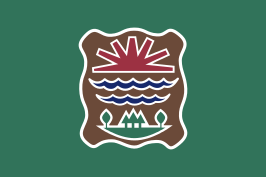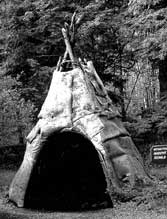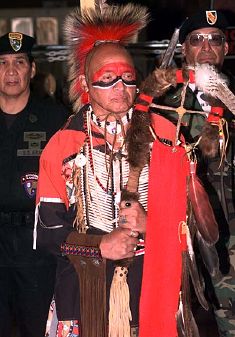Abenaki
| Abenaki |
|---|

|
| Flag of Western Abenaki |
| Total population |
| around 4,500 |
| Regions with significant populations |
| United States (Maine, New Hampshire, Vermont) Canada (Quebec) |
| Languages |
| English, Abenaki |
| Religions |
| Related ethnic groups |
| Algonquian peoples |
The Abenaki (or Abnaki) are a tribe of Native American and First Nations people belonging to the Algonquian peoples of northeastern North America, located in area the Eastern Algonquian languages call the "Wabanaki" (Dawn Land) Region. The Abenakis were one of the five members of the Wabanaki Confederacy.
Name
The Abenaki people call themselves Alnôbak, meaning "Real People" (c.f. Lenape language: Lenapek). In addition, when compared to the more interior Algonquian peoples, they call themselves Wôbanuok meaning "Easterners" (c.f. Massachusett language: Wôpanâak). They also refer to themselves as Abenaki or with syncope: Abnaki. Both forms are derived from Wabanaki or the Wabanaki Confederacy, as they were once a member of this confederacy they called Wôbanakiak meaning "People of the Dawn Land" in the Abenaki language—from wôban ("dawn" or "east") and aki ("land")[1] (compare Proto-Algonquian *wa·pan and *axkyi)—the aboriginal name of the area broadly corresponding to New England and the Maritimes. It is, therefore, sometimes used to refer to all the Algonquian language speaking peoples of the area—Western Abenaki, Eastern Abenaki, Wolastoqiyik-Passamaquoddy, and Micmac—as a single group.
Subdivisions
Historically, the Abenakis are divided by the ethnologists into groups: Western Abenaki and Eastern Abenaki. Within these groups are the Abenaki Bands:
|
|
However, due to erroneous use of the word "Abenaki" to mean "Wabanaki," all the Abenakis together with the Penobscots are often described as "Western 'Abenaki'" peoples, while the Mi'kmaq, Maliseet and Passamaquoddy are described as "Eastern 'Abenaki'" peoples.
Location
The homeland of the Abenaki, known to them as Ndakinna, which means "our land," extended across most of northern New England, southern Quebec, and the southern Canadian Maritimes. The Eastern Abenaki's population was concentrated in portions of Maine east of New Hampshire's White Mountains. The other major tribe, the Western Abenaki, lived in the Connecticut River valley in Vermont, New Hampshire and Massachusetts.[2] The Missiquoi lived along the eastern shore of Lake Champlain. There were also the Pennacook along the Merrimack River in southern New Hampshire. The maritime Abenaki lived around St. Croix and the Wolastoq (St. John River) Valleys near the boundary line between Maine and New Brunswick.
The settlement of New England and frequent wars caused many Abenakis to resort to retreating to Quebec. Two large tribal communities formed near St-Francois-du-Lac and Bécancour. These settlements continue to exist to this day. Three reservations also exist in northern Maine, and seven Wolastoqiyik (Maliseet) reserves are located in New Brunswick and Quebec. Other groups of Abenaki, without reservations, are scattered across northern New Hampshire and Vermont.[3]
The Penawapskewi (Penobscot) have a reservation with 2,000 people on Indian Island at Old Town, Maine. The Pestomuhkati (Passamaquoddy) currently [citation needed] number about 2,500 across three different Maine reservations, Pleasant Point, Peter Dana Point, and Indian Township. The Houlton Band of Maliseet Indians have close to 600 tribesmembers, whereas there are seven Wolastoqiyik (Maliseet) bands in Canada, 470 in Quebec and 2,000 in New Brunswick. Four hundred Wôlinak Abenakis live on a reserve near Bécancour, Quebec (across the river from Trois-Rivières), and almost 1,500 live at Odanak, only 30 miles to the southwest of Trois-Rivières. The remaining Abenaki people are scattered within Quebec, New Brunswick, and northern New England, living in multi-race towns and cities. There are currently [citation needed] about 2,500 Vermont Abenaki in both Vermont and New Hampshire, mainly around Lake Champlain.[3]
Language
There are two primary dialects of Abenaki: Western Abenaki, the language of the Abenaki community at Odanak, and Eastern Abenaki, which is represented by the modern language of the Penobscot tribe, as well as in the Abenaki linguistic materials of the colonial French missionaries.[citation needed]
The Abenaki language is closely related to those of their neighboring Wabanaki tribes such as the Mi'kmaq, Wolastoqiyik (Maliseet), and Pestomuhkati (Passamaquoddy), as well as with other Eastern Algonquian languages. There were numerous cultural differences between the Algonquian tribes and those of the Five Nations with linguistic and spiritual differences being the most noticeable.[citation needed]
There are very few native speakers of the original Abenaki language still alive. There are active Abenaki communities in Quebec, Vermont, Maine, and New Hampshire.[citation needed]
Their language has been preserved in the monumental Abenaki-French dictionary of Sebastian Râle, in Joseph Laurent's 1884 grammar, and in the 1994 dictionary by Gordon Day.[citation needed] Other dictionaries are Chief Henry Lorne Masta's 1932 Abenaki Legends, Grammar, and Place Names, Odanak, Que., and Abbé Aubery's 1700 Abenaki dictionary, "French-Abenaki Dictionary," translated into English, published 1995 by Chief Stephen Laurent (son of Joseph). Fluent speaker Joseph "Elie" Joubert also has language lists of words, available via Alnôbak News, Franklin, MA.
History
The first record of their encountering Europeans was in 1603, when the English explorer Martin Pring set dogs on them.[citation needed] In 1604, George Weymouth kidnapped a group and took them to England.[citation needed] In 1614, Thomas Hunt captured twenty four young people and took them to England.[4]
The Abenakis were traditionally allied with the French; one of them, Chief Assacumbuit, was declared a noble under the reign of Louis XIV.
Facing annihilation from English attacks and epidemics, they started to emigrate to Quebec around 1669, where two municipalities were given to them. The first was on the Saint Francis River and is nowadays known as the Odanak Indian Reservation; the second was founded near Bécancour and is called the Wolinak Indian Reservation.
When their principal town, Norridgewock, was taken, and their missionary, Father Sebastian Râle, killed in 1724, many more emigrated to the settlement on the St. Francis River where other refugees from the New England tribes had come to earlier. As of the early 1900s, they were represented by the Wolastoqiyik ("People of the good river" – Maliseet) on the St. John River, New Brunswick, and Quebec (, on the bay of that name, in Maine (300); the Penobscots, at Old Town, Maine (400), and the Abnakis at St. Francis and Bécancour, Quebec (430).[citation needed]
Abenakis are not a federally recognized tribe in the United States, like many other eastern tribes. This may change: in 2006, Vermont officially recognized the Abenaki as a People, but not a Tribe. This is in recognition of the annihilation or assimilation of the Abenaki and subsequent isolation of each small remnant of the greater whole onto reservations during and after the French and Indian War well before the US government began acknowledging the sovereignty of native tribes in the late twentieth century. Facing annihilation, the Abenakis began emigrating to Canada, then under French control, around 1669 where they were granted two seigneuries. The first seigneurie was established on the Saint-François river and is now known as the Odanak Indian Reserve; the second was established on the river Bécancour and is now known as the Wôlinak Indian Reserve.[citation needed]
A tribal council was organized in 1976 at Swanton, Vermont as the Sokoki-St. Francis Band of the Abenaki Nation. State recognition of the council was granted that same year but was later withdrawn for unknown reasons. In 1982, they applied for nation recognition which is still pending. In 1980 two small councils united to form the Northeast Woodland-Coos Band, now known as the Koasek Traditional Band. [3][citation needed]
Culture
There are a dozen variations of the name Abenakis, such as Abenaquiois, Abakivis, Quabenakionek, Wabenakies and others.
They were described in the Jesuit Relations as not cannibals, and as docile, ingenious, temperate in the use of liquor, and not profane.[5]
All Abenaki tribes lived a lifestyle similar to the Algonquin of southern New England. They largely relied on horticulture when it came to their diet, which is why villages often were located on or near river floodplains. Other less major, but still important parts of their diet include hunting, fishing, and wild plant gathering.[3]
They lived in scattered bands of extended families for most of the year. Each man had different hunting territories inherited through his father. The Abenaki were patrilineal, unlike the Iroquois. Bands would come together during the spring and summer at temporary villages near rivers, or somewhere along the seacoast for planting and fishing. These villages occasionally had to be fortified, depending on the alliances and enemies of other tribes or of Europeans near the village. Abenaki villages were quite small when compared to the Iroquois', the average number of people only being 100.[3]
Most Abenaki settlements used dome-shaped, bark covered wigwams for housing, though a few preferred oval-shaped long houses. During the winter, the Abenaki lived in small groups farther inland. The homes there were bark-covered wigwams shaped in a way similar to the teepees of the Great Plains Indians.[3] During the winter the Abnaki would line the inside of their conical wigwams with bear and deer skins. The Abenaki also built long houses similar to those of the Iroquois.[6]
Mythology
Government
The Abenaki were ruled by elected chiefs called Sachems, who usually served for life but could be impeached. They had little actual power, but European colonizers still treated them like monarchs, resulting in many miscommunications and oversimplifications.[citation needed]
Population and epidemics
Before the Abenaki—except the Pennacook and Micmac—had contact with the European world, their population may have numbered as many as 40,000. Around 20,000 would have been Eastern Abenaki, another 10,000 would have been Western Abenaki, and the last 10,000 would have been Maritime Abenaki. Early contacts with European fisherman resulted in two major epidemics that affected Abenaki during the 1500s. The first epidemic was an unknown sickness occurring sometime between 1564 and 1570, and the second one was typhus in 1586. Multiple epidemics arrived a decade prior to the English settlement of Massachusetts in 1620, when three separate sicknesses swept across New England and the Canadian Maritimes. Maine was hit very hard during the year of 1617, with a fatality rate of 75%, and the population of the Eastern Abenaki fell to about 5,000. Fortunately, the Western Abenaki were a more isolated group of people and suffered far less, losing only about half of their original population of 10,000.[3]
The new diseases continued to cause more disaster, starting with smallpox in 1631, 1633, and 1639. Seven years later, an unknown epidemic struck, with influenza passing through the following year. Smallpox affected the Abenaki again in 1649, and diphtheria came through 10 years later. Once again, smallpox struck in 1670, and influenza again in 1675. Smallpox affected the Native Americans again in 1677, 1679, 1687, along with measles, 1691, 1729, 1733, 1755, and finally in 1758.[3]
The Abenaki population continued to decline, but in 1676, they took in thousands of refugees from many southern New England tribes displaced by settlement and King Philip's War. Because of this, descendents of nearly every southern New England Algonquin can be found among the Abenaki people. Another century later, there were fewer than 1,000 Abenaki remaining after the American Revolution.
The population recovered to almost 12,000 in both the United States and Canada.
Fiction
The Abenaki are featured in Jodi Picoult's Second Glance and the film Northwest Passage based on Kenneth Roberts's book Arundel.
They also feature prominently in Charles McCarry's novel Bride of the Wilderness.
They also plays a protagonist role in Joseph Bruchac's novel The Arrow Over the Door.
Notable people
- Alanis Obomsawin, filmmaker and documentarian
- Donald E. Pelotte, Roman Catholic Bishop of Gallup
- Alexis Wawanoloath, Quebec MNA
- Joseph Bruchac, an author
Footnotes
- ↑ Snow, Dean R. 1978. "Eastern Abenaki." In Northeast, ed. Bruce G. Trigger. Vol. 15 of Handbook of North American Indians, ed. William C. Sturtevant. Washington, D.C.: Smithsonian Institution, pg. 137. Cited in Campbell, Lyle (1997). American Indian Languages: The Historical Linguistics of Native America. Oxford: Oxford University Press, pg. 401. Campbell uses the spelling wabánahki.
- ↑ Waldman, Carl. Encyclopedia of Native American Tribes: Third Edition (New Yrok: Checkmark Books, 2006) p. 1
- ↑ 3.0 3.1 3.2 3.3 3.4 3.5 3.6 3.7 Abenaki
- ↑ Bourne, p.214
- ↑ (1900) in Reuben Gold Thwaites: Travels and Explorations of the Jesuit Missionaries in New France, 1610—1791. The Burrows Company. Retrieved 2006-11-07.
- ↑ Waldman, Encyclopedia of Native American Tribes p. 1
ReferencesISBN links support NWE through referral fees
- Bourne, Russell, The Red King's Rebellion, Racial Politics in New England 1675-1678, 1990, ISBN 0689120001
Bibliography
- Maurault, Joseph-Anselme; Histoire des Abénakis, depuis 1605 jusqu'à nos jours, 1866
- Moondancer and Strong Woman. 2007. A Cultural History of the Native Peoples of Southern New England: Voices from Past and Present. Boulder, CO: Bauu Press. ISBN 07213493X
- Laurent, Joseph. [1884] 2006. New Familiar Abenakis and English Dialogues. Vancouver: Global Language Press. ISBN 0973892471
- Masta, Henry Lorne. [1932] 2008. Abenaki Legends, Grammar and Place Names. Toronto: Global Language Press. ISBN 978-1897367186
External links
- Abenaki Nation
- Koasek Abenaki Nation
- http://www.elnuabenakitribe.org
- The Abenaki Language
- Abenaki language resources at native-languages.org
- Abenaki Language Sample at Language Museum
- Waban-Aki Nation, Quebec
- (French) Abenaki Museum, Odanak, Quebec
- (French) Abenaki danse group
- The Abenaki
Credits
New World Encyclopedia writers and editors rewrote and completed the Wikipedia article in accordance with New World Encyclopedia standards. This article abides by terms of the Creative Commons CC-by-sa 3.0 License (CC-by-sa), which may be used and disseminated with proper attribution. Credit is due under the terms of this license that can reference both the New World Encyclopedia contributors and the selfless volunteer contributors of the Wikimedia Foundation. To cite this article click here for a list of acceptable citing formats.The history of earlier contributions by wikipedians is accessible to researchers here:
The history of this article since it was imported to New World Encyclopedia:
Note: Some restrictions may apply to use of individual images which are separately licensed.


